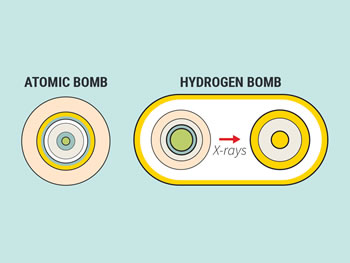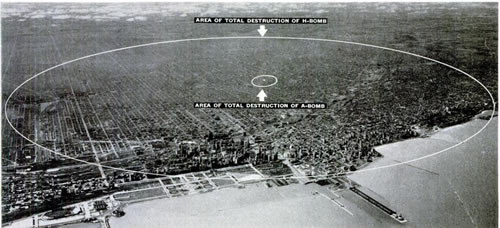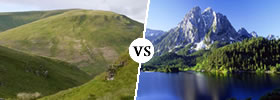Difference between a Hydrogen Bomb and an Atomic Bomb
Key Difference: The primary difference between a Hydrogen Bomb and an Atomic Bomb is that an Atomic Bomb used nuclear fission of create the energy blast, whereas a Hydrogen Bomb uses nuclear fusion. A Hydrogen Bomb is far deadlier and dangerous than an Atomic Bomb.
 The term Atomic Bomb or atom bomb tends to make people nervous and even scared, and with good reason. It is a devastating device that can kill millions of people in one go, and can level a whole city within seconds, not accounting for the years of radioactive radiation it leaves behind. It is not a power that anyone should have over someone else.
The term Atomic Bomb or atom bomb tends to make people nervous and even scared, and with good reason. It is a devastating device that can kill millions of people in one go, and can level a whole city within seconds, not accounting for the years of radioactive radiation it leaves behind. It is not a power that anyone should have over someone else.
One of the largest atomic bombs developed has the destruction power of up to 500 kilotons of TNT. In comparison, the first ever atomic bomb used in warfare in Hiroshima, Japan in 1945 had a blast yield of 15 kilotons of TNT. While an atom bomb is bad, a hydrogen bomb is even worse. It is capable of much more damage than an atomic bomb. The most powerful hydrogen bomb developed till date has a blast yield of15000 kilotons, which is a thousand times worse than the first atom bomb. Technically speaking, there is no limit to the blast yield of a hydrogen bomb, which makes it even more dangerous.
Both are types of nuclear weapons, also colloquially known as weapons of mass destruction. Both are capable of great destruction; however they differ in the manner that they react in order to bring about this said destruction. The atomic bomb is a type of fission based nuclear weapon, which basically means that it uses a fission reaction to create heat and energy. Here, the energy is created by assembling enriched uranium or plutonium into a supercritical mass and then by either by shooting one piece of sub-critical material into another, which is called the gun method, or by compressing using explosive lenses a sub-critical sphere of material using chemical explosives to many times its original density, which is known as the implosion method. The implosion method is used only with plutonium and does not work with uranium. For uranium, the gun method is more popular.
The hydrogen bomb, on the other hand, uses a fusion type reaction. They are also commonly referred to as thermonuclear weapons. The sun is a natural fusion reactor that gives off heat and light. Here, the energy is created by using a hydrogen based isotope, most popularly deuterium and tritium. The process of a fusion reaction actually involves a fission reaction, which is necessary to set off the fusion reaction. In fact, it is possible that a significant amount of energy released in a fusion reaction comes from the fission reaction.
 The energy from fission reaction is used to compress and heat fusion fuel, which mostly consists of hydrogen isotopes, primarily tritium, deuterium, or lithium deuteride. These isotopes are placed in proximity within a special, radiation-reflecting container. The gamma rays and X-rays which are expelled from a fission reactions force the hydrogen isotopes to compress, thus creating enormous numbers of high-speed neutrons, which can then induce fission in materials not normally prone to it, such as depleted uranium. Hence, it can be said that the fusion reaction is in two stages. The primary one is the fission bomb, whereas the secondary on is the fusion capital.
The energy from fission reaction is used to compress and heat fusion fuel, which mostly consists of hydrogen isotopes, primarily tritium, deuterium, or lithium deuteride. These isotopes are placed in proximity within a special, radiation-reflecting container. The gamma rays and X-rays which are expelled from a fission reactions force the hydrogen isotopes to compress, thus creating enormous numbers of high-speed neutrons, which can then induce fission in materials not normally prone to it, such as depleted uranium. Hence, it can be said that the fusion reaction is in two stages. The primary one is the fission bomb, whereas the secondary on is the fusion capital.
In comparison, Hydrogen bombs are much more powerful than atomic bombs and can result in a much larger destruction than just an atom bomb. Also, while atomic bombs have been around for a while, at least since the 1940s, the hydrogen bombs were developed much later. Through there are successful hydrogen bombs out there, they have never been used in a war, whereas the Atomic Bomb has been used twice, and both times in World War II.
Comparison between a Hydrogen Bomb and an Atomic Bomb:
|
|
Hydrogen Bomb |
Atomic Bomb |
|
Type |
Nuclear Weapon, weapon of mass destruction |
Nuclear Weapon, weapon of mass destruction |
|
Reaction |
Fusion Based |
Fission Based |
|
Core |
Hydrogen isotopes deuterium and tritium |
Uranium and plutonium, specifically uranium 235 and plutonium 239 |
|
|
|
|
|
Power |
More powerful |
Less Powerful |
|
Blast Yield |
Up to 15,000 kilotons, but technically has no limit. |
Can range from a ton to upwards of 500,000 tons (500 kilotons) of TNT |
|
War uses |
Not used in war till date |
Hiroshima and Nagasaki in World War II |
Reference: Wikipedia, CGTN, NDTV, LiveScience, Science Alert, Encyclopedia Image Courtesy: businessinsider.com, robertchaen.wordpress.com









Comments
Ryan
Fri, 01/26/2018 - 04:36
RYAN
Wed, 01/03/2018 - 08:49
RYAN
Tue, 12/12/2017 - 22:29
Ryan
Fri, 11/17/2017 - 20:21
Add new comment